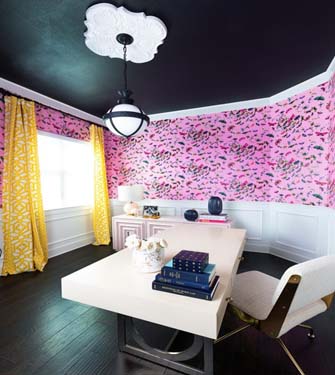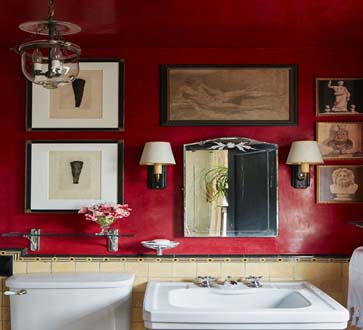Something bold lies up ahead—and above our head—in the new year. Jazzing up your ceiling—A.K.A. the “fifth wall”—can add dimension and character to virtually any room. While many of us have tackled an accent wall by ourselves, taking the DIY approach for a painted ceiling is a hairier beast. That said, the resulting space is definitely worth the climb (up the literal and metaphorical ladder, that is). “A painted ceiling is unexpected and automatically creates a big impact,” says designer Emilie Munroe of Studio Munroe.
To help you plan, prep, and execute a painted ceiling, we’ve listed tips from a paint pro and an interior design maven—paired with inspiration from ELLE Decor’s archives. Read on for the best tips on how to paint your ceiling.
GENERAL PRECAUTIONS
“Painting your ceiling is not something you’re going to want to do very often,” says Jamie Davis, co-founder of Portola Paints & Glazes. “So you should be extra thoughtful when choosing a color and finish.” While opting for a bold color can be a part of the fun of painting your ceiling, don't let that dictate which shade you'll choose. Something as simple as selecting a shade darker or lighter than your walls can be all you need to make an impact.

CEILING PAINT VS. WALL PAINT
“Generally I’d say that painting your ceiling before painting your walls is preferable,” Davis says. “That way, if you get overspray on your walls, it won’t really matter because you’ll be painting your walls next. In the rare occasion that you are using a darker accent color on the ceiling—or not painting your walls—you may need to drape a thin sheet of plastic over your walls to protect from overspray.” You can use the same type of paint on both your ceiling and walls, though often times designers will choose a shade with a different finish to add subtle contrast.

PREP YOUR SPACE
Unless you figure out a way to defy gravity, a bit of paint is going to drip down. It’s really no biggie; just prepare by laying and securing drop cloths to your floor. You can protect your own mug by throwing on a hat and a pair of safety glasses. “I bought a pair of cheap clear lens glasses from the drugstore that I wear when painting ceilings,” Davis says. “Also, an old hat or bandana to keep overspray out of my hair.”
PICK A COLOR
In the same way a white ceiling will open up and brighten a room, a darker ceiling will bring definition and cozy vibes to a large space. On that same note, your tiny bedroom might turn into a closet if you paint it black; stick to lighter shades if you are worried about a room becoming claustrophobic.
“We love a jewel tone on the ceiling,” says Emilie Munroe. “Cobalt, emerald, and raspberry are favorites. It's also ideal to have crown molding as the wood trim acts as a frame to the accent color.”
CONSIDER YOUR LIGHTING...
According to Jamie Davis, “Light source and temperature will have a huge impact on how colors and finishes will read. Chandeliers will generally cast a warm, candle-like light.” Emilie Munroe agrees: “Any room with a sculptural central chandelier is a great option for a painted ceiling as the color will draw the eye upward.”
If you're trying to create an eye-catching appeal with a painted ceiling, put the spotlight on it! We also recommend testing different bulbs to see which type of lighting best reflects against the ceiling and its shade/finish.
…AND YOUR DESIGN STYLE
While a painted ceiling can work with practically any design style, some shades and finishes will enhance—or disrupt—your aesthetic goals. “I think that a painted ceiling will work with any design style,” Munroe says. “If you’re going for high impact, pull a complementary color for the ceiling from the wallpaper on the wall. For a modern look, almost any color pulled from an accent piece in the room will pair beautifully with white walls.”
DECIDE BETWEEN GLOSSES
“I use an Ultra-Flat paint on ceilings 99% of the time. Flat paint will hide imperfections and not reflect light the way eggshell or semi-gloss paints will,” says Jamie Davis. A flat or matte finish will hide imperfections, but a high-gloss lacquer finish can help bounce light throughout the room and make the ceiling look higher.
DECIDE BETWEEN GLOSSES
“I know the high-gloss/lacquered look is really cool, and budget permitting can add a level of design that can be an amazing statement. When painting anything with a gloss—especially a ceiling—you’ll need to make sure that your surface is incredibly smooth and free of any drywall seams as to not show imperfections.”
WORK YOUR WAY DOWN
If you plan on painting the whole room, start with the ceiling and work your way down. If you are just painting the ceiling, apply painters' tape around the edges to avoid drippings.
USE A ROLLER
You want a roller with a thinner knap to avoid drippings when painting a ceiling. Opt for a deeper knap to fill in grooves, as needed, if your ceiling is textured. And, to state the obvious, get as close to your ceiling as possible. Use a short, light roller at an angle that won’t put extra strain on your back and painting arm. “Overspray from a roller can and will get everywhere so you’ll also want to make sure you remove as much furniture from the room as possible,” Davis explains.
Otherwise, this is going to be a long and painful home renovation project.



















Your Message